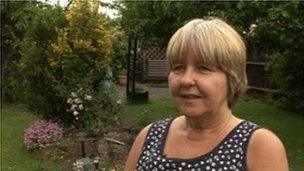Peer-to-peer lending via the internet hits £250m
- Published

Lynne Martin's money is spread among hundreds of borrowers, thus reducing risk
Lending via three websites that link savers with borrowers - bypassing the banking system - has topped £250m.
The "new age" finance carries no protection for deposits, but is being tipped as a serious threat to traditional banks.
The peer-to-peer sites are led by Zopa, which has lent more than £200m since it started in 2005.
Funding Circle, specialising in business loans, has topped £34m, and RateSetter has reached £24m.
Last month the government said it would lend these sort of firms £100m to help expand their own lending to businesses.
"It's a marketplace, the eBay for money," says Lynne Martin from Hertfordshire, a foot technician in her late 50s who has been using Zopa to build up a nest egg for retirement.
Higher returns
Lynne was fed up with the returns she was getting from banks and pension plans.
So she has lent a substantial part of her savings via the website, spreading it between hundreds of borrowers and by-passing the banking system.
The interest from the latest £5,000 is 7.4% a year before tax but after taking into account Zopa's 1% charge.
That is substantially more than is available on a typical savings account at a bank.
On the other side of the ledger, Jamie Hirst from Chippenham in Wiltshire has borrowed £4,500 through Zopa to cover the cost of a revamp of his kitchen and bathroom.
The 8.4% APR he is paying is 5% less than he was quoted by his bank.
"I thought it was brilliant," he told the BBC's Your Money.
"The fact that there wasn't some fat cat taking the profits, just some guy investing 50 or a hundred quid to get a little return and doing something good for someone else."
The drawbacks
There is a significant drawback for savers: the lack of any guarantee that you will get your money back.
Peer-to-peer lending, as it is known, does not qualify for protection from the <link> <caption>Financial Services Compensation Scheme (FSCS)</caption> <url href="http://www.fscs.org.uk/" platform="highweb"/> </link> , which provides security up to £85,000 per bank, for each saver.
The peer-to-peer sites put their loan applicants through credit checks and Zopa says it divides people's savings into £10 chunks which are spread between borrowers, to minimise any risk.
On average, so far, its lenders have lost 0.5% of their money as a result of borrowers defaulting.
But Lynne Martin predicts the concept is bound to catch on more widely.
"Necessity is the mother of invention," she says.
"This is a new asset class. It's not a share and it's not a bank account."
Official support?
Lynne has support from a director of the Bank of England, Andy Haldane, who suggested in March that peer-to-peer lenders could replace High Street banks.

Jamie Hirst has been able to borrow money at a cheaper rate than from his bank
"There is no reason why end-savers and end-investors cannot connect directly," he explained.
"The banking middle men may in time become the surplus links in the chain."
Lynne is hoping the interest she is earning will help pay for her to retire to the West Country, a hope which highlights an interesting feature of peer-to-peer lending.
Much of the money has been moving across generations, from older people looking for a decent income to younger borrowers setting up in life and desperate to keep down the cost of taking a loan.